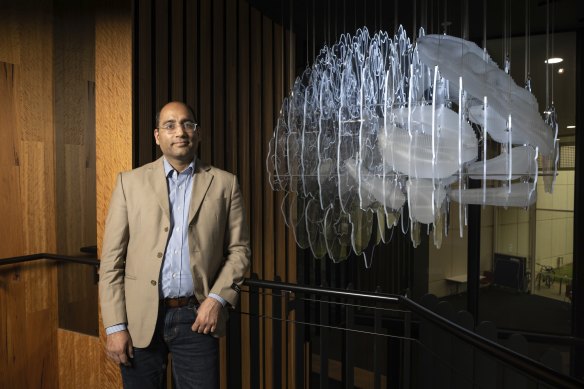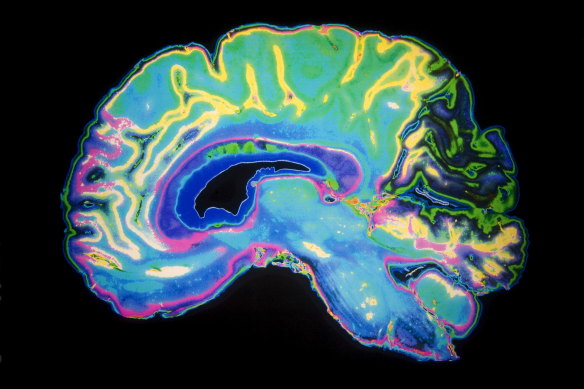The onset of dementia could be predicted almost a decade before symptoms appear using a new test that researchers hope could lead to earlier support and improved treatments.
The test, developed by an international research team including a neuroscientist from Monash University, was created by analysing MRI scans to detect changes in some parts of the brain.

Associate Professor Adeel Razi was part of the international research team that developed a test that could predict the onset of dementia earlier.Credit: Penny Stephens
The research team says the test can predict dementia with more than 80 per cent accuracy and up to nine years before a diagnosis.
Dementia, which can cause memory loss and affect thinking, behaviour and mood, is the second leading cause of death in Australia after heart disease. It affects more than 55 million people worldwide, including more than 400,000 Australians.
However, many people are diagnosed only when they have problems with memory or cognition, by which point the dementia may have been progressing for years and caused irreversible damage to brain cells.
“Our new method for predicting who will develop dementia well in advance will be a game changer, enabling the development of therapies earlier in the disease process,” said Associate Professor Adeel Razi, from Monash University’s School of Psychological Sciences and the Turner Institute for Brain and Mental Health.
Razi said identifying individuals at risk of dementia years before symptoms appeared would enable them to be treated before there was a lot of damage to the brain cells.
“With a nine-year warning there’s time to actually focus on people who will get dementia with new technology and medication and disease modifying therapies coming in,” Razi said.
“All of the clinical trials in finding medication and therapy have failed because they have focused on curing the disease after the damage to the brain has already been done.
“But with our tests, we would be able to treat a brain with less progressed disease and these therapies would have higher chance of working. It is early days, but it is a significant finding.”
Recent studies have also demonstrated the potential for blood tests that detect specific proteins to predict dementia more than 10 years before the condition is formally diagnosed in patients.
However, the new method – which is published in the peer-reviewed journal Nature Mental Health – uses MRI scans to detect changes in the brain’s default mode network.
Professor Charles Marshall of the Queen Mary University of London, who led the research team, said the two methods of predicting dementia were complementary.
“Combining blood tests with a measure of how your brain starts to change allows us to be much more precise,” he said.

The brain’s default mode network – which is engaged when people are in a resting state – is the first neural network to be affected by Alzheimer’s, the most common disease that causes dementia.
Disruptions in the default mode network begin long before people show signs of Alzheimer’s.
The researchers looked at MRIs from the UK Biobank, which holds detailed health information on half a million volunteers. They analysed the scans of 81 people who developed dementia up to nine years after imaging and 1030 matched controls.
From this, they developed a model that enabled accurate predictions about whether and when an individual would develop dementia.
Marshall said he hoped the predictive test would be used to select people to participate in trials for treatments to prevent dementia.
“We know that we can’t replace brain cells once they are lost to dementia, so focusing on ways to prevent them from being lost is definitely the way we should be thinking,” he said.
“But we’ve got a long way to go to get there and one of the things to do is identify risk.”
Dementia Australia welcomed the focus on predicting dementia but said it was important that this was not at the expense of those already living with dementia.
“Whilst it is really important that we do identify people much earlier, because any future disease modifying medications are likely to have much more efficacy, they’re still not going to be for everybody,” said Dr Kaele Stokes, the executive director of services, advocacy and research at Dementia Australia.
“There are 421,000 people living with dementia now who require support and care and co-ordination and all of the things that will support them to live as well as possible.”
The Morning Edition newsletter is our guide to the day’s most important and interesting stories, analysis and insights. Sign up here.
Most Viewed in National
https://news.google.com/rss/articles/CBMijgFodHRwczovL3d3dy5zbWguY29tLmF1L25hdGlvbmFsL3dhbnQtdG8ta25vdy1pZi15b3UtcmUtYXQtcmlzay1vZi1kZW1lbnRpYS1hLW5ldy10ZXN0LXByb21pc2VzLXRvLWRldGVjdC1pdC15ZWFycy1lYXJsaWVyLTIwMjQwNjA2LXA1ampvOC5odG1s0gGOAWh0dHBzOi8vYW1wLnNtaC5jb20uYXUvbmF0aW9uYWwvd2FudC10by1rbm93LWlmLXlvdS1yZS1hdC1yaXNrLW9mLWRlbWVudGlhLWEtbmV3LXRlc3QtcHJvbWlzZXMtdG8tZGV0ZWN0LWl0LXllYXJzLWVhcmxpZXItMjAyNDA2MDYtcDVqam84Lmh0bWw?oc=5
2024-06-06 09:00:00Z
CBMijgFodHRwczovL3d3dy5zbWguY29tLmF1L25hdGlvbmFsL3dhbnQtdG8ta25vdy1pZi15b3UtcmUtYXQtcmlzay1vZi1kZW1lbnRpYS1hLW5ldy10ZXN0LXByb21pc2VzLXRvLWRldGVjdC1pdC15ZWFycy1lYXJsaWVyLTIwMjQwNjA2LXA1ampvOC5odG1s0gGOAWh0dHBzOi8vYW1wLnNtaC5jb20uYXUvbmF0aW9uYWwvd2FudC10by1rbm93LWlmLXlvdS1yZS1hdC1yaXNrLW9mLWRlbWVudGlhLWEtbmV3LXRlc3QtcHJvbWlzZXMtdG8tZGV0ZWN0LWl0LXllYXJzLWVhcmxpZXItMjAyNDA2MDYtcDVqam84Lmh0bWw
Bagikan Berita Ini














0 Response to "Want to know if you’re at risk of dementia? A new test promises to detect it years earlier - Sydney Morning Herald"
Post a Comment